Extensive Jurassic World Interview With Director Colin Trevorrow
On July 21st 2014, I was lucky to visit the New Orleans set of Jurassic World. (You can read a list of over 50 things I learned on the Jurassic World set here.) While on set, we got the chance to have an extensive sit-down interview with Jurassic World director Colin Trevorrow, which was conducted during the crew lunch break on a recreation of the famous visitors center from Jurassic Park. (A location which, in the film's story, is now abandoned.) Producer Frank Marshall joined us late in the conversation.
Our conversation spanned a variety of topics, including the use of performance capture to create the dinosaurs in the new film, the idea of Weird Al having a song in the new film, bringing an independent style to the shoot, and the evolution of the Jurassic Park 4 script over the last ten years. We went into the reasons for the infamous production delay, input from Steven Spielberg, and what to expect from the new dino species.
There were fun details, too, like how a conversation with his son about Star Wars resulted in major change to the script, allegories to Black Fish and Sea World, the dinosaur stand-ins on set, and how Brad Bird not directing Star Wars resulted in Steven Spielberg finding Colin.
As I said before, the interview is extensive and so you'll want to carve out some time to read this. Trust me, its good.
Colin Trevorrow Jurassic World Interview
Question: I think the most important question we need to start off with is this: has Weird Al been contacted, and should we expect him or a song of his in the movie?Colin Trevorrow: –Man, what an amazing resurgence. So awesome. No, I think that's–yeah, we probably should get in touch. I have a hard time–I take it all so seriously, I have to remember not to sometimes. Not to be too serious, at least.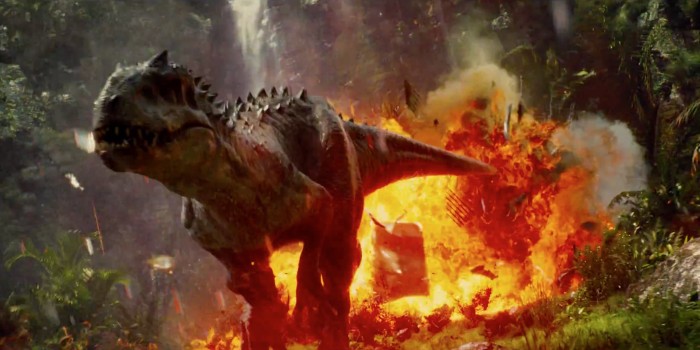 Question: Right. You were telling us before about how the dinosaurs are created in this film using performance capture. That's the first in Jurassic Park history, right?Colin Trevorrow: Absolutely.Question: Can you talk about why you made that choice?Colin Trevorrow: It's something that ILM has been developing for a while and I went up there in September last year and I was able to sit on a stage and just move somebody around a space and just understand the fundamentals of how it worked. And there were a lot of questions as to whether that process could work for the larger animals. We knew it would work for the raptors because they're at least somewhat human in height. But, when you get down to a 20 foot high, 50 foot long animal, is that going to translate? And then they tended to hone it and it really does. I'm not sure why, but the physics work and it's pretty thrilling to watch. I think living things can recognize the movement of other living things and all the best animators in the world can't quite capture that something.
Question: Right. You were telling us before about how the dinosaurs are created in this film using performance capture. That's the first in Jurassic Park history, right?Colin Trevorrow: Absolutely.Question: Can you talk about why you made that choice?Colin Trevorrow: It's something that ILM has been developing for a while and I went up there in September last year and I was able to sit on a stage and just move somebody around a space and just understand the fundamentals of how it worked. And there were a lot of questions as to whether that process could work for the larger animals. We knew it would work for the raptors because they're at least somewhat human in height. But, when you get down to a 20 foot high, 50 foot long animal, is that going to translate? And then they tended to hone it and it really does. I'm not sure why, but the physics work and it's pretty thrilling to watch. I think living things can recognize the movement of other living things and all the best animators in the world can't quite capture that something.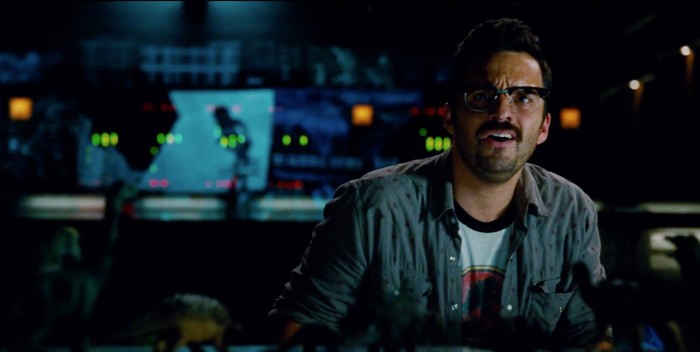 Question: Jake was saying that he wasn't surprised that you were doing this jumping from Safety [Not Guaranteed] to a movie of this level and that essentially you're shooting it like you would an Indie movie anyway. Is that sort of how you felt going in, like not intimidated at all by this?Colin Trevorrow: No. I feel more comfortable doing this than being an actual person in real life. So, yeah, we're not shooting it like an Indie movie all the time. I mean, it's very carefully planned. And, it's a different style of filmmaking. I think even on Safety, it was frustrating for me because I didn't really get to film-make in a traditional sense. It was more like pointing the video cameras and say the words. The sun is going down.Press: That is filmmaking.Colin Trevorrow: That is filmmaking. That's true. It's a different kind. Yeah. And I loved it. And we're–even today–today was a more improvisation looser kind of day than we would normally have, but that's really the challenge is to keep things feeling spontaneous in a movie like this. I think it's one of the first things to go in a movie of this size is spontaneity. But, also the style of this film is so different from Safety in that every shot is designed and it's not really a B camera that works that well that often except for situations like that we really try to tell the story, you know, with imagery in the way that Steven is brilliant at. And so, it's not just point and shoot is my point.
Question: Jake was saying that he wasn't surprised that you were doing this jumping from Safety [Not Guaranteed] to a movie of this level and that essentially you're shooting it like you would an Indie movie anyway. Is that sort of how you felt going in, like not intimidated at all by this?Colin Trevorrow: No. I feel more comfortable doing this than being an actual person in real life. So, yeah, we're not shooting it like an Indie movie all the time. I mean, it's very carefully planned. And, it's a different style of filmmaking. I think even on Safety, it was frustrating for me because I didn't really get to film-make in a traditional sense. It was more like pointing the video cameras and say the words. The sun is going down.Press: That is filmmaking.Colin Trevorrow: That is filmmaking. That's true. It's a different kind. Yeah. And I loved it. And we're–even today–today was a more improvisation looser kind of day than we would normally have, but that's really the challenge is to keep things feeling spontaneous in a movie like this. I think it's one of the first things to go in a movie of this size is spontaneity. But, also the style of this film is so different from Safety in that every shot is designed and it's not really a B camera that works that well that often except for situations like that we really try to tell the story, you know, with imagery in the way that Steven is brilliant at. And so, it's not just point and shoot is my point.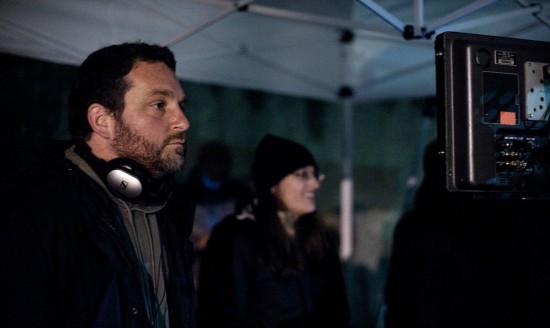 Question: So, what was the origins of you coming on? Did you go in and pitch or–you pitch your take on it? Or did they call you in after seeing the movie? Or–.
Question: So, what was the origins of you coming on? Did you go in and pitch or–you pitch your take on it? Or did they call you in after seeing the movie? Or–.
Colin Trevorrow: –I didn't. No. Yeah. Steven saw the film and Frank gave me a call. And asked me to come out. We talked for about two hours and then they flew me to L.A. a couple days later and Steven and I talked for a couple of hours and then he gave me Jurassic Park because it was a very strange week. You know, I don't know exactly why he made that choice. Part of me feels like he wanted a child in the way that, like, Willy Wonka did–Who, like–you know, wouldn't screw up the chocolate factory. But, you know–and as far as,I didn't pitch anything because I didn't know what the movie was about and I was hired before I'd even seen the script. They were still working on a draft and then I saw it and it was a very tough moment in my life because I realize I didn't understand how to direct that screenplay and tell that story. And so, I had to go back to them and say, look, I'll go home to Vermont but, it's either that or Derek and I build a new movie called Jurassic Park IV and that's what it was called at the time. And so, we just started doing it, essentially. We just got in a hotel and we started writing and I was designing the sequences by day at work while writing the thing based on, you know, this new outline that had come to us very quickly. I was saying to you guys before,I think all of us could write a Jurassic Park movie if called upon to do so. And so, it was suggested, I was activated and it all came very easily to me. I wrote–like, the outline for the movie, I wrote essentially, the Tuesday morning, I woke up at 4 a.m. and knowing I was going to go into work and tell Frank what I had tell him. Wrote a whole outline but there were two ideas from the earlier drafts that were very interesting. I was telling you earlier that the park existed and the idea that there was, even though the nature of it was different, that there was a dinosaur that had to be stopped that was killing everything in its path. And it kind of–essentially the idea that there was a human who had a relationship with the raptors that echoes relationships we have with animals today.
But, I felt like it really needed to be pulled way, way, way back. But, I read a lot of your websites and I know that it's a draft doesn't work or isn't ultimately used, it's suggested that those people did a bad job or–and it's really not that. It's that, developing a Jurassic Park movie took 14 years and it's really hard. And the benefit of drafts like what John Sayles did and what Rick and Amanda did, they put the orange cones around all the potholes. And so, you get to look straight down the road. And there's an advantage. And hopefully, people will respect the drafts that I've written that have been thrown out for the future. It happens to all of us.
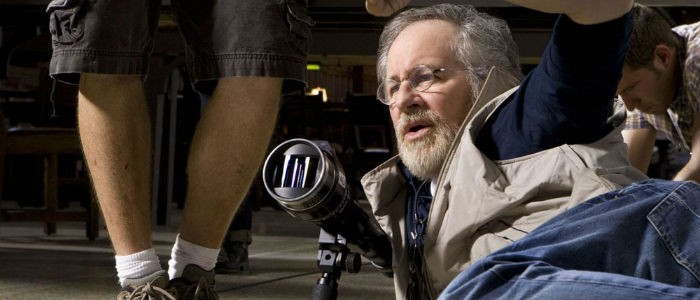 Question: What happened when–like, you guys were going to go into production and then that got delayed. So, what exactly was the holdup there?Colin Trevorrow: The holdup was really all about making sure we could accomplish what we wanted to accomplish. And I was hired in March. We wrote the first draft in a couple of weeks and we were developing it and working on it with Steven and getting it at a place for a June start, which is no way to make a movie. And it was all really about making it for a release date. And we just reached this point where all the things you've seen here, we wouldn't have been able to build in the time we had. It was all going to be in the computer. I wasn't going to be able to build the park that we constructed and I just reached this point that we realize in order to execute that particular vision, we could've made a movie.
Question: What happened when–like, you guys were going to go into production and then that got delayed. So, what exactly was the holdup there?Colin Trevorrow: The holdup was really all about making sure we could accomplish what we wanted to accomplish. And I was hired in March. We wrote the first draft in a couple of weeks and we were developing it and working on it with Steven and getting it at a place for a June start, which is no way to make a movie. And it was all really about making it for a release date. And we just reached this point where all the things you've seen here, we wouldn't have been able to build in the time we had. It was all going to be in the computer. I wasn't going to be able to build the park that we constructed and I just reached this point that we realize in order to execute that particular vision, we could've made a movie.
But luckily, Steven is one of the few people in this industry who can call the studio and say, you know what? We're going to take a little more time and get this right. And it was the day I think giving me the movie wasn't the gift, giving me the extra year was the gift. So, we spent three months over the summer honing what we had and dialing it in and really just making it something that could be called Jurassic Park without being embarrassed for itself, be ashamed to look in the mirror. And I'm–I mean, I'm happy we did.
Question: You mentioned that Steven sort of maybe viewed you as the child he was handing it off to. I mean, there is that changeover happening now with George Lucas passing along Star Wars. He's passed along Jurassic Park. The old guard is changing. Is it an exciting way to come into the established franchises? Or do you also think that creating new tentpoles instead of bringing back ones that you grew up with?Colin Trevorrow: It's so funny. I read certain articles about how all of the new filmmakers are immediately being given massive tent poles and there's a lot of original movies that we have now lost as a result of this. I don't want to call it a fad because I think it's a good thing. I think the movies are better as a result. But, it's very important to me to be able to tell original stories and I'm hoping that I can at least go back and forth. Because look, I love big movies. I love the kind of movies I watched when I was a kid. But, I also love telling great stories. And I think that it was actually the first thing I said to Steven when we sat down and he was suggesting this. However flattered I was, I acknowledged — I was, like, look, man, let's just acknowledge, this is the most amazing thing that's ever happened to me. Let's put it on the table right now. That said, he had the privilege of making a series of original movies that allowed him to build a voice and identity as a filmmaker over a long period of time. And by doing this, I am essentially being robbed of that in exchange for the best thing that ever happened to anyone. So, you weigh that. And in the end, I felt like I had a responsibility to do it mostly, you know, for Steven. In thanks for everything he's done for all of us and how much his movies meant to me and to my childhood, but also if one is asked to do this, it's almost insulting to everyone else to say no. We would all love this privilege to be able to recreate a film that meant so much to us.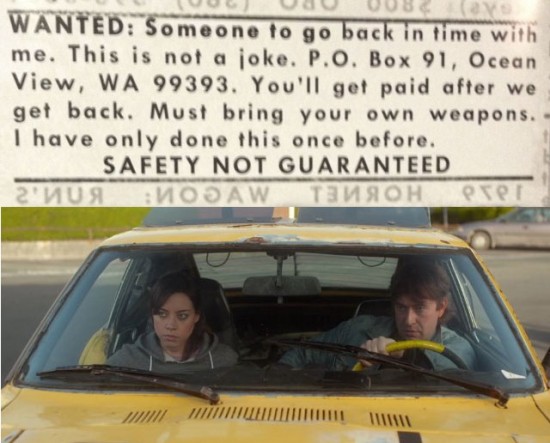 Question: Do you think doing this kind of movie will open up more opportunities for you to more of the smaller movies that you want to do?Colin Trevorrow: I suppose so. You know, I live in Vermont. I'm not really part of the system. I don't go to the parties and I just feel like people are aware my services are available. And if they're interested, they can call. But–.Press: –What's the number?Colin Trevorrow: Yeah, it's available.Press: It's in the phone book.Colin Trevorrow: Yeah. And I think that I definitely respond to things on a gut level and I responded to the story that we built on a real gut level. I really think it's a kind of movie we haven't seen in a long time and it's not just the kind of film that Jurassic Park was, but it's a big romantic adventure. There's a lot of Romancing the Stone in this movie, and a little Indiana Jones and it's kind of all of things I love. It's not just the one. And it even feels or all–like, there's something about Star Wars that feels like you're intercutting between completely different planets, completely different environments. And this movie has that, too. And the place you're seeing today and then we're intercutting with deep jungle and people jumping off of waterfalls and it really goes a lot of places.
Question: Do you think doing this kind of movie will open up more opportunities for you to more of the smaller movies that you want to do?Colin Trevorrow: I suppose so. You know, I live in Vermont. I'm not really part of the system. I don't go to the parties and I just feel like people are aware my services are available. And if they're interested, they can call. But–.Press: –What's the number?Colin Trevorrow: Yeah, it's available.Press: It's in the phone book.Colin Trevorrow: Yeah. And I think that I definitely respond to things on a gut level and I responded to the story that we built on a real gut level. I really think it's a kind of movie we haven't seen in a long time and it's not just the kind of film that Jurassic Park was, but it's a big romantic adventure. There's a lot of Romancing the Stone in this movie, and a little Indiana Jones and it's kind of all of things I love. It's not just the one. And it even feels or all–like, there's something about Star Wars that feels like you're intercutting between completely different planets, completely different environments. And this movie has that, too. And the place you're seeing today and then we're intercutting with deep jungle and people jumping off of waterfalls and it really goes a lot of places.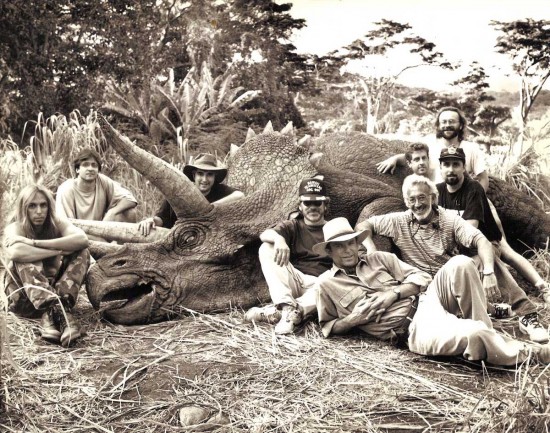 Question: From Steven's point of view, I'm just so interested, again, about, like, just the way–again, handing off–sort of the passing of the torch in a way. I mean, he did that with Jurassic Park III because Joe Johnston did that. But, I mean–.Colin Trevorrow: –Joe was up here.Press: Right. Exactly. He's watching the new class and George Lucas, too, just watching these people who were kids when these movies come out. When you spoken to him about it, does he sort of have a–how does he feel about and could he ever see handing over E.T. to someone else? I mean, is this sort of that step of, like, you know–?Colin Trevorrow: That I don't know. I know this franchise means a lot to him. It's very personal to him. Indiana Jones was a collaboration with George Lucas. It has different identity. And I know what he liked about Safety Not Guaranteed, which is that that movie posed a question throughout the film and he loved the answer on a very fundamental level. And I think that my instinct to be able to have something be funny and sad and thrillery and weird and in this case, horrifying, you know, Jurassic Park doesn't have a genre. Like, what is Jurassic Park? It's a sci-fi, terror, family adventure thriller? It's hard to define and being able to bounce around from all these different tones and do something that hits all the notes, I would hope it's that. I didn't win a contest or anything. So, I hope it's that.
Question: From Steven's point of view, I'm just so interested, again, about, like, just the way–again, handing off–sort of the passing of the torch in a way. I mean, he did that with Jurassic Park III because Joe Johnston did that. But, I mean–.Colin Trevorrow: –Joe was up here.Press: Right. Exactly. He's watching the new class and George Lucas, too, just watching these people who were kids when these movies come out. When you spoken to him about it, does he sort of have a–how does he feel about and could he ever see handing over E.T. to someone else? I mean, is this sort of that step of, like, you know–?Colin Trevorrow: That I don't know. I know this franchise means a lot to him. It's very personal to him. Indiana Jones was a collaboration with George Lucas. It has different identity. And I know what he liked about Safety Not Guaranteed, which is that that movie posed a question throughout the film and he loved the answer on a very fundamental level. And I think that my instinct to be able to have something be funny and sad and thrillery and weird and in this case, horrifying, you know, Jurassic Park doesn't have a genre. Like, what is Jurassic Park? It's a sci-fi, terror, family adventure thriller? It's hard to define and being able to bounce around from all these different tones and do something that hits all the notes, I would hope it's that. I didn't win a contest or anything. So, I hope it's that.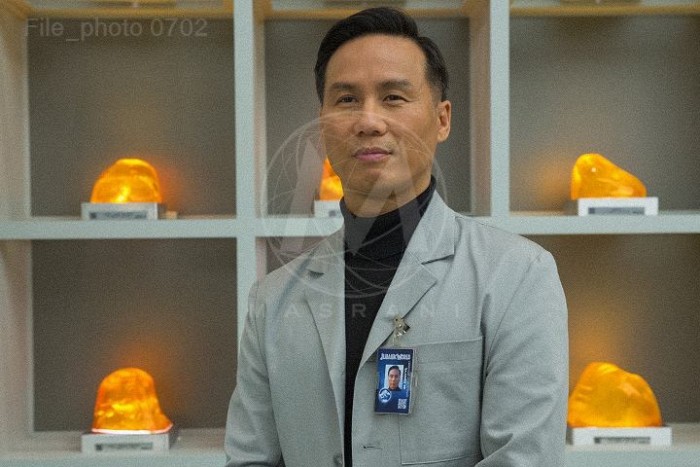 Question: Was there any pressure to continue the story with some of the characters we know or anything like that? Or was it like, no, you just start all over, do what you want?Colin Trevorrow: Certainly not from Steven. I think that was part of it is he really wanted to know, what did we see? What do we want to see? And I think the reason why he took so long is, you know, no one really knows the answer of how to do this. And I think that I looked at it and explained to you on your website (referring to my interview with Colin from during production) how I felt about it. But, it's the difference between going back to your old elementary school and walking the halls and going back to your elementary school and seeing your teacher who is 20 years older. And I think the more sentimental feeling for me is when I'm alone, walking the halls, and having memories and it's echoing. That was what I wanted to bring back.
Question: Was there any pressure to continue the story with some of the characters we know or anything like that? Or was it like, no, you just start all over, do what you want?Colin Trevorrow: Certainly not from Steven. I think that was part of it is he really wanted to know, what did we see? What do we want to see? And I think the reason why he took so long is, you know, no one really knows the answer of how to do this. And I think that I looked at it and explained to you on your website (referring to my interview with Colin from during production) how I felt about it. But, it's the difference between going back to your old elementary school and walking the halls and going back to your elementary school and seeing your teacher who is 20 years older. And I think the more sentimental feeling for me is when I'm alone, walking the halls, and having memories and it's echoing. That was what I wanted to bring back.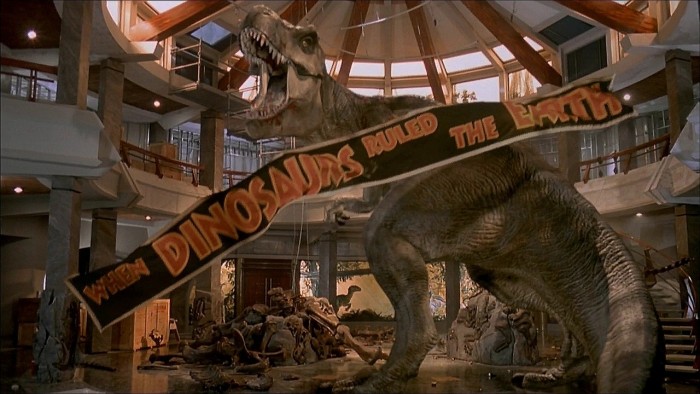 Question: I expected maybe there's a cameo–like, a human cameo of some kind. But, you mentioned earlier that there's a dinosaur that we have seen in the previous films that we're going to get to see. Can you talk a little bit about that?Colin Trevorrow: The T-Rex that's in the film is the T-Rex from the original Jurassic Park and she is 22 years older. But, she's not limping around.Question: Does she still have a taste for raptors?Colin Trevorrow: We'll see. We will see.Question: Will audiences immediately recognize that it's the same–?Colin Trevorrow: –I hope so. Yeah. I mean, we took the original design and obviously, technology has changed. So, it's going to move a little bit differently, but it'll move differently because it's older. And we're giving her some scars and we're tightening her skin. So, she has that feeling of, like, an older Burt Lancaster. And this movie is her Unforgiven.
Question: I expected maybe there's a cameo–like, a human cameo of some kind. But, you mentioned earlier that there's a dinosaur that we have seen in the previous films that we're going to get to see. Can you talk a little bit about that?Colin Trevorrow: The T-Rex that's in the film is the T-Rex from the original Jurassic Park and she is 22 years older. But, she's not limping around.Question: Does she still have a taste for raptors?Colin Trevorrow: We'll see. We will see.Question: Will audiences immediately recognize that it's the same–?Colin Trevorrow: –I hope so. Yeah. I mean, we took the original design and obviously, technology has changed. So, it's going to move a little bit differently, but it'll move differently because it's older. And we're giving her some scars and we're tightening her skin. So, she has that feeling of, like, an older Burt Lancaster. And this movie is her Unforgiven.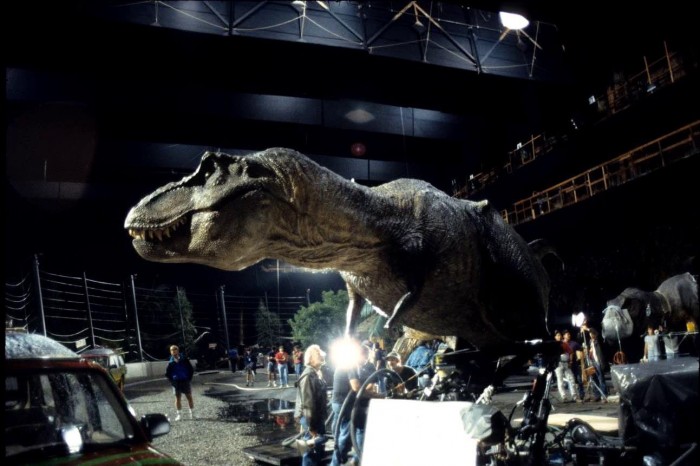 Question: Did you get to build her again?Colin Trevorrow: We got to build everyone from the ground up because technology has changed so much that everything is a rebuild. And I got to bring in dinosaurs that I've always thought deserved a big scene. There's an Ankylosaurus in this movie; was a really big scene and that's just a bad ass dinosaur. And there are others. There's smaller appearances, some bigger appearances. You know, we have an underwater reptile. I'm sure you've heard about that. That thing is pretty cool. We have a new kind of flying dinosaur that no one's ever seen before, you know, in addition to the Pteranodons that are really scary. And I didn't want to just throw the kitchen sink at it. Each of these movies has done a good job at just very carefully, in a measured way, increasing the new dinosaurs that you see. But, there's a lot of dinosaurs in the movie for sure.
Question: Did you get to build her again?Colin Trevorrow: We got to build everyone from the ground up because technology has changed so much that everything is a rebuild. And I got to bring in dinosaurs that I've always thought deserved a big scene. There's an Ankylosaurus in this movie; was a really big scene and that's just a bad ass dinosaur. And there are others. There's smaller appearances, some bigger appearances. You know, we have an underwater reptile. I'm sure you've heard about that. That thing is pretty cool. We have a new kind of flying dinosaur that no one's ever seen before, you know, in addition to the Pteranodons that are really scary. And I didn't want to just throw the kitchen sink at it. Each of these movies has done a good job at just very carefully, in a measured way, increasing the new dinosaurs that you see. But, there's a lot of dinosaurs in the movie for sure.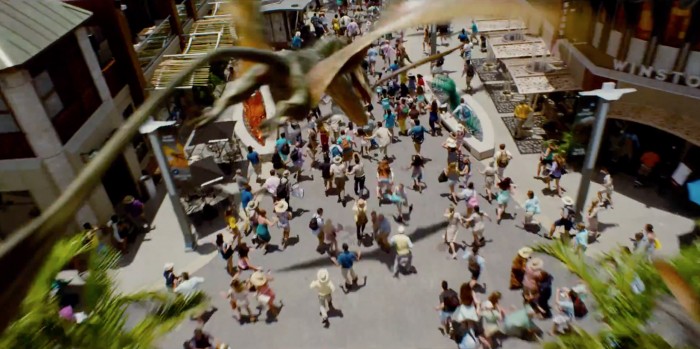 Question: How do you control flying dinosaurs?Colin Trevorrow: Well, I mean, you don't. That's kind of the point.Question: Can you say if you're going to be dealing with the other islands at all?Colin Trevorrow: No, this is all set right here. And we're not ignoring the other two films but, being that they took place on another island, this is–we're focusing on the history and the future of this island.Question: When I asked if you got to rebuild the T-Rex, I meant more in a practical–.Colin Trevorrow: –Oh, in a practical sense. Well–.
Question: How do you control flying dinosaurs?Colin Trevorrow: Well, I mean, you don't. That's kind of the point.Question: Can you say if you're going to be dealing with the other islands at all?Colin Trevorrow: No, this is all set right here. And we're not ignoring the other two films but, being that they took place on another island, this is–we're focusing on the history and the future of this island.Question: When I asked if you got to rebuild the T-Rex, I meant more in a practical–.Colin Trevorrow: –Oh, in a practical sense. Well–.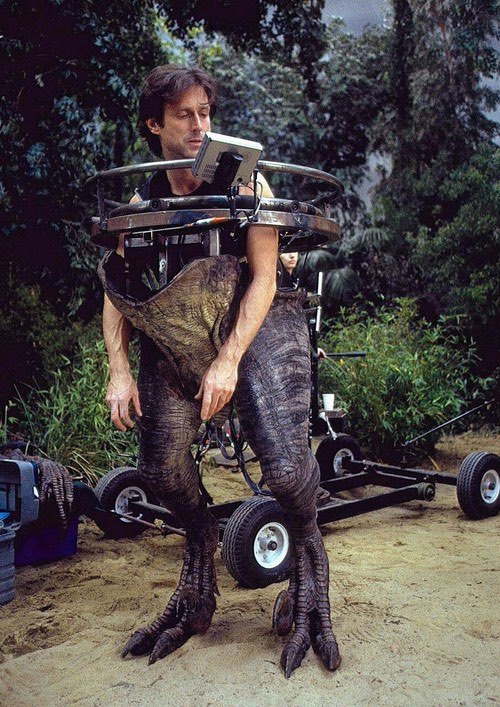
BTS The Lost World
Question: –Did you–can you talk a little bit about some of the practical versus CG?Colin Trevorrow: A little, yeah. I mean, we have ond scene that is an animatronic animal. I don't want to tell you the nature of it, but it's really beautiful and it's a real tribute to Stan Winston and what he did. And there's other elements of–it's just a very special moment. So, that's something I want people to discover. But, there's other elements where animatronics are used just so people can touch them. And there's other moments where maybe in the past they would've used an animatronic. They might've built, you know, a giant head but because a scene is so short or brief in which you just see the head, we've tried to, you know, keep that motion and that sense of, like, slow wait. So, even some of the CG animals will look animatronic based on the way that they move because usually when you get really up close to the head, there was just that sense that it could crush you if you got underneath it. And it's very difficult to do with CG, but we've come so far that we always try to have it interact with something practical. Little things move. So, I think however far the animatronics take us, I think people will feel like we maybe used more than we did just because the way we're executing it.Question: You were speaking of the mystery box earlier and sort of that era being over. But, one of the keys to the first Jurassic Park was hiding the dinosaurs for the longest time. You never saw them in the trailers. Can you pull that off here? Or do you think audiences are expecting to see a dino in the trailer just to know what you're working with now? Like, what sort of surprise–?Colin Trevorrow: I think we'll really do hold off that something that we focused on a lot and–you know, but hopefully not in a way that's frustrating for people. And then when we go big... When it happens, it happens. And that's–you know, that's a real–I was saying earlier, that's the privilege that we have. The advantage of this movie is that our first 45, 50 minutes we get to build and just be with people in a real place that they're experiencing and then pull the rug out. So, it doesn't start off with an opening scene with dinosaurs all around you. It really does slow build. So, I just think it's a more effective way to tell a story.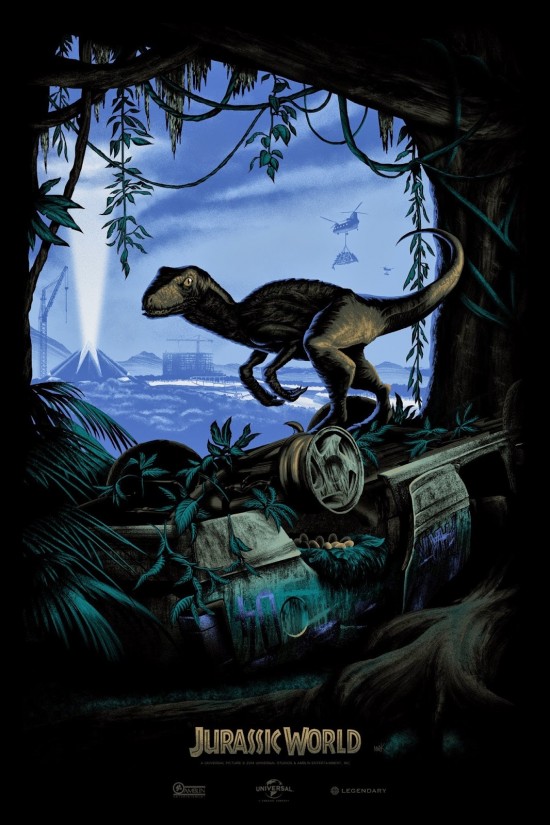 Question: But, even in the early advertising terms because that was really the thing back when Jurassic Park advertised, you never showed any. And I remember a famous [unintelligible] religiously back then, it was–there was that picture of, like, a dinosaur under wraps. Like, literally, it was Steven Spielberg sitting on top of it and it was saying, like, no one see it. No one knew how these dinosaurs were going to look. So, can you get away with that kind of, like, CG–?Colin Trevorrow: –We'll do it for some. You know, others–you know, I obviously sat down with the Universal marketing people and you can have this one and it's almost like cards. I want all of these ones. So, they're–you know, it's a big movie and I know that I want it to do well very well at the studio. And I need them to be able to, you know, bring people to the table. But, I feel like we have, like, two images that we can show that if you see that, I think you're going to want to go see it. So, we'll be very careful and just, show you something really good.
Question: But, even in the early advertising terms because that was really the thing back when Jurassic Park advertised, you never showed any. And I remember a famous [unintelligible] religiously back then, it was–there was that picture of, like, a dinosaur under wraps. Like, literally, it was Steven Spielberg sitting on top of it and it was saying, like, no one see it. No one knew how these dinosaurs were going to look. So, can you get away with that kind of, like, CG–?Colin Trevorrow: –We'll do it for some. You know, others–you know, I obviously sat down with the Universal marketing people and you can have this one and it's almost like cards. I want all of these ones. So, they're–you know, it's a big movie and I know that I want it to do well very well at the studio. And I need them to be able to, you know, bring people to the table. But, I feel like we have, like, two images that we can show that if you see that, I think you're going to want to go see it. So, we'll be very careful and just, show you something really good.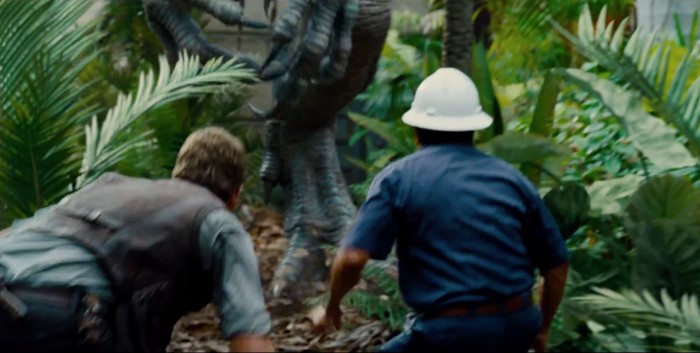 Question: Are the hybrids the ones that you're more protective of?Mr. Colin Trevorrow: Hybrid. There's only one.Press: The hybrid.Colin Trevorrow: And that came for my son, actually. There was a moment–because... there's the synthetic and there are the organic and they're the dinosaurs that we know and love. And there's this thing that has to be eliminated. And it came from my son. In an earlier draft of the script, there was a moment when he realized that there was another and that they were making more and that kind of thing. And my son, who's five, saw Star Wars for the first time. And he had seen Jedi; I showed him to him. You know, I waited, like, nine months between. I separated it for him. And then he saw Jedi and he had only seen those three. And he was, like, I don't understand. Like, if Leia is also a Jedi, then Luke isn't unique. It was, like, oh, you're right. There can be only one hybrid dinosaur. So, there will be only one and it's because of my five-year-old son who made a quite astute observation about Luke Skywalker.
Question: Are the hybrids the ones that you're more protective of?Mr. Colin Trevorrow: Hybrid. There's only one.Press: The hybrid.Colin Trevorrow: And that came for my son, actually. There was a moment–because... there's the synthetic and there are the organic and they're the dinosaurs that we know and love. And there's this thing that has to be eliminated. And it came from my son. In an earlier draft of the script, there was a moment when he realized that there was another and that they were making more and that kind of thing. And my son, who's five, saw Star Wars for the first time. And he had seen Jedi; I showed him to him. You know, I waited, like, nine months between. I separated it for him. And then he saw Jedi and he had only seen those three. And he was, like, I don't understand. Like, if Leia is also a Jedi, then Luke isn't unique. It was, like, oh, you're right. There can be only one hybrid dinosaur. So, there will be only one and it's because of my five-year-old son who made a quite astute observation about Luke Skywalker.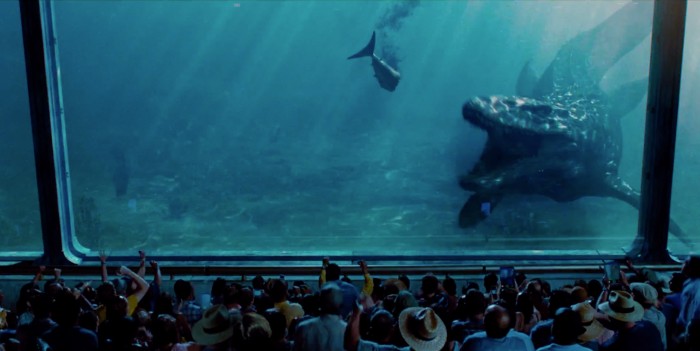 Question: I know Spielberg is busy doing his films and stuff but he worked with you on the script. I've heard so many great stories about how he comes in and has an idea or pluses or some kind of moment. Can you give any story about how he's influenced your film?Colin Trevorrow: I can give an example. You know, beyond the script stage, I had an idea and you'll see this–by the time you guys are able to write about this, people will have seen this image. But, I had an idea for we have the Mosasaurus, which is the underwater reptile. And I came to him and I had a piece of art. I was, like, here's the deal, man. So, there's going to be this arena and it's like at Sea World and there'll be a lady out front and be, like, well, you know, she didn't eat yet today, everybody. So, let's hope she's still hungry. Like, super perky. And this mosasaurus will rise up out of the water and eat a shark, what do you think? And he has to be in on it. And he's, like, no, I get it. I see what you're doing. And I'm cool with it. But, what would be really cool is if afterwards–after she eats the shark, if she goes underwater and then all the bleachers sink down underwater into a tank and you can watch her finish it off and just see the blood. Like, Jesus, okay. Yeah, all right, we'll do that. That sounds great. So, it's really–it's improv. It's like a yes and kind of a game. And there have been a couple moments throughout. In the past month or so we haven't spoken as much because he seen the dailies every day and he's happy with what we're doing. But, occasionally, he would see what we're doing and say, you know, this is the thing I was going to show you. He'd say, oh, no, you need a shot to show the scale of animal. So he would draw a picture on, like, a notepad, you know, not necessarily beautifully designed. But, I would get–I know I have it in here somewhere. Here we go. So, he'd be, like, oh, you see, you need to have them–he's got to sniff behind the crane, right? And then, you know, then we reveal him under the tire. And then, like, you know, here's the move and you start pulling back. Like, all right. I'll go shoot that. No problem.
Question: I know Spielberg is busy doing his films and stuff but he worked with you on the script. I've heard so many great stories about how he comes in and has an idea or pluses or some kind of moment. Can you give any story about how he's influenced your film?Colin Trevorrow: I can give an example. You know, beyond the script stage, I had an idea and you'll see this–by the time you guys are able to write about this, people will have seen this image. But, I had an idea for we have the Mosasaurus, which is the underwater reptile. And I came to him and I had a piece of art. I was, like, here's the deal, man. So, there's going to be this arena and it's like at Sea World and there'll be a lady out front and be, like, well, you know, she didn't eat yet today, everybody. So, let's hope she's still hungry. Like, super perky. And this mosasaurus will rise up out of the water and eat a shark, what do you think? And he has to be in on it. And he's, like, no, I get it. I see what you're doing. And I'm cool with it. But, what would be really cool is if afterwards–after she eats the shark, if she goes underwater and then all the bleachers sink down underwater into a tank and you can watch her finish it off and just see the blood. Like, Jesus, okay. Yeah, all right, we'll do that. That sounds great. So, it's really–it's improv. It's like a yes and kind of a game. And there have been a couple moments throughout. In the past month or so we haven't spoken as much because he seen the dailies every day and he's happy with what we're doing. But, occasionally, he would see what we're doing and say, you know, this is the thing I was going to show you. He'd say, oh, no, you need a shot to show the scale of animal. So he would draw a picture on, like, a notepad, you know, not necessarily beautifully designed. But, I would get–I know I have it in here somewhere. Here we go. So, he'd be, like, oh, you see, you need to have them–he's got to sniff behind the crane, right? And then, you know, then we reveal him under the tire. And then, like, you know, here's the move and you start pulling back. Like, all right. I'll go shoot that. No problem.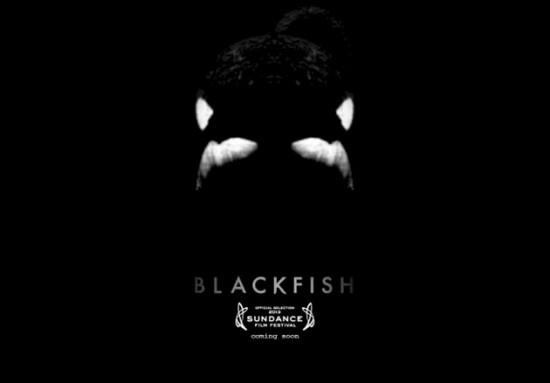 Question: Given the way that some of the sharks are treated at Sea World, or how they were treated, but it did kind of surprise me that there aren't, like Jurassic Park protesters like there are protesters of Sea World.Colin Trevorrow: Right.Question: Was that an avenue that you thought at all? Like, animal rights activists would be up in arms about, like, this idea of genetically engineered dinosaurs in captivity?Colin Trevorrow: I think there would be. I think that's something I might want to save. There's a lot that happens in this movie. There is a character that has, because yeah, there's a bit of a Black Fish vibe to this story. That's all there. And so, I wanted to introduce a world where people hadn't, you know–we don't really go too far outside the island. And so, it's a bit of a bubble. When you're there, you're presented with this very corporately stylized experience. And then the cracks begin to show. And that's why there's so much of it. There's not a lot of product placement in the movie where people do this, but everything's labeled and everything's named. There's a Starbucks on the corner. And that, to me–to be able to build all of that and then have the oldest creatures on the planet tear it apart was very exciting to me. Very exciting.
Question: Given the way that some of the sharks are treated at Sea World, or how they were treated, but it did kind of surprise me that there aren't, like Jurassic Park protesters like there are protesters of Sea World.Colin Trevorrow: Right.Question: Was that an avenue that you thought at all? Like, animal rights activists would be up in arms about, like, this idea of genetically engineered dinosaurs in captivity?Colin Trevorrow: I think there would be. I think that's something I might want to save. There's a lot that happens in this movie. There is a character that has, because yeah, there's a bit of a Black Fish vibe to this story. That's all there. And so, I wanted to introduce a world where people hadn't, you know–we don't really go too far outside the island. And so, it's a bit of a bubble. When you're there, you're presented with this very corporately stylized experience. And then the cracks begin to show. And that's why there's so much of it. There's not a lot of product placement in the movie where people do this, but everything's labeled and everything's named. There's a Starbucks on the corner. And that, to me–to be able to build all of that and then have the oldest creatures on the planet tear it apart was very exciting to me. Very exciting.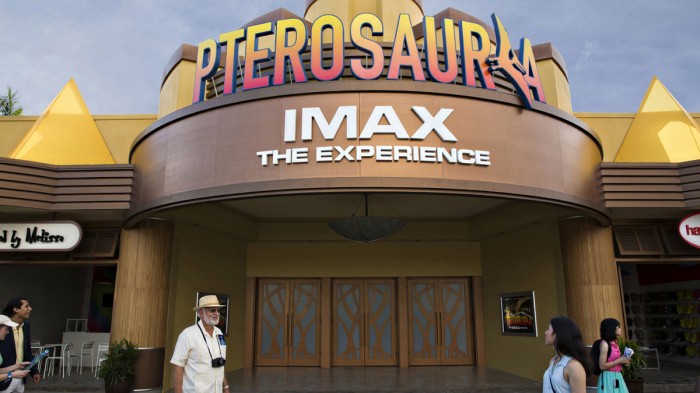 Question: Were the brands excited to have that happen? Or–yeah?Colin Trevorrow: Everybody knows they're getting torn apart. They're totally down with it. No, that was one of the cool things. And we have partners on this movie who totally get it. We have a Ben & Jerry's, which being from Vermont, that was like, the one they made a flavor and everything. And no, I think the sense that this is a real place is so pervasive. When you watch the movie, I think there'll be kids–remember after Avatar, like people were, like, I have to go back to that place and they went through all that stuff. I think there'll be kids who will just be, like, I have–I must go there. I have to go to this place. And because it's real, I think you can sense when there's a CG building, you know. These are real buildings and it's a real gyrosphere and you saw it.
Question: Were the brands excited to have that happen? Or–yeah?Colin Trevorrow: Everybody knows they're getting torn apart. They're totally down with it. No, that was one of the cool things. And we have partners on this movie who totally get it. We have a Ben & Jerry's, which being from Vermont, that was like, the one they made a flavor and everything. And no, I think the sense that this is a real place is so pervasive. When you watch the movie, I think there'll be kids–remember after Avatar, like people were, like, I have to go back to that place and they went through all that stuff. I think there'll be kids who will just be, like, I have–I must go there. I have to go to this place. And because it's real, I think you can sense when there's a CG building, you know. These are real buildings and it's a real gyrosphere and you saw it.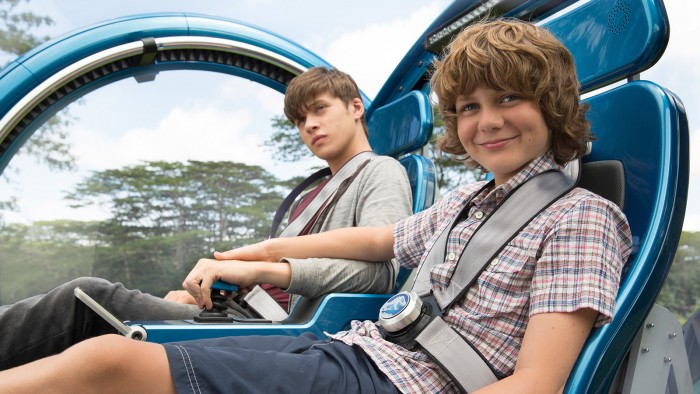 Press: Yeah. I want to go in one of those.Colin Trevorrow: My kid got to ride in one. He was a very lucky kid. And he would get in there and we had this loading station for it that we built on this mountain side. And it has a track. It would actually come in, you could get into it, and it rolls you right out. So, we would have them, you know, use the thing and the guy had the remote control and he was totally convinced. Like, go forward, Nolan. And he would go and he would be able to reverse. And man, if I had that when I was a child. I tried to explain it. You don't–some day, you will understand how awesome this is. It's really awesome, man. It's really awesome.
Press: Yeah. I want to go in one of those.Colin Trevorrow: My kid got to ride in one. He was a very lucky kid. And he would get in there and we had this loading station for it that we built on this mountain side. And it has a track. It would actually come in, you could get into it, and it rolls you right out. So, we would have them, you know, use the thing and the guy had the remote control and he was totally convinced. Like, go forward, Nolan. And he would go and he would be able to reverse. And man, if I had that when I was a child. I tried to explain it. You don't–some day, you will understand how awesome this is. It's really awesome, man. It's really awesome.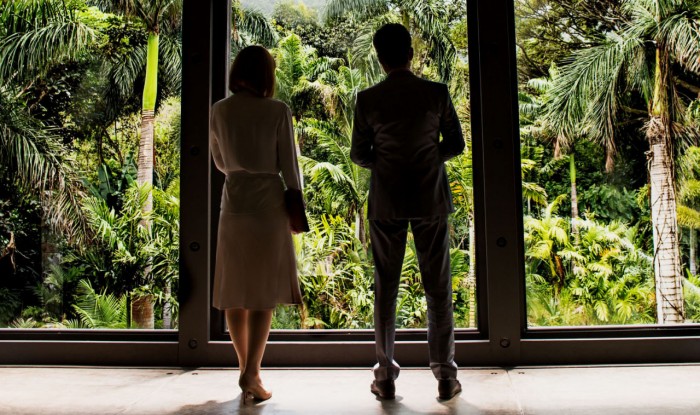 Question: You know, we've been talking about the dinosaurs and the park, but we haven't been talking about the characters at all. So, tell us about the characters. Like, who are the characters of this world?Colin Trevorrow: Well, the movie is essentially a romantic adventure. It takes place between Bryce Dallas Howard's character who runs this park and sees the dinosaurs as assets and things that are to be – she is sort of Malcolm's worst nightmare of, like, you stood on the shoulders of the giants and now, you just want to sell it. You want to sell it. That's her. And then Chris Pratt, who is ex-military; a guy who is sort of out on the fringes of this park, doing some behavioral research with the raptors. And that story links in to Vince D'Onofrio's character who's our villain and it all comes together. But, the middle of the movie is essentially Owen and Claire out in the jungle looking for these two boys who are her nephews who came from Wisconsin at the beginning of the movie and her sister while mediating their divorce has sent them to be with her sister in Jurassic World. And the first thing she does is give them passes and, you know, you're going to be fine. And she's busy. She moves on and these get into a horrifying scenario involving the gyrosphere, our new dinosaur, which is kind of out killing for sport because it grew up in captivity. It's sort of, like, if the black fish orca got loose and never knew its mother and has been fed from a crane. And when you make a hybrid animal–like, any farmer will tell you that, like, hybrid cows are crazy. So, it's crazy. And also having been raised in the way that it is that when it finally gets out, it's just everything it sees. And so, they get into a situation involving that and Ankylosaurus, which has a tail that allows it to hit that ball like a pinball machine. And it's actually ended up being scarier than I thought it was going to be. But, those two kids are out on the jungle on their own and it's a little bit of Stand by Me as these guys–these brothers are trying to find their way out. And they end up making it here and get out here in a pretty cool way that I'm very excited about. And then the last third of the movie is just straight up terror. It's just horrifying. It's so scary.Question: It does sound like you're going back to one of the core of elements of the first movie which was the family. I mean, not a traditional family because it's got–.Colin Trevorrow: A matrix family.Question: Yeah, and then that teaches them to become a family. But, that's the part of it. Like, these two coming together to care for kids and then becoming a–.Colin Trevorrow: You know, we really worked–I think these boys will be very well received as far as Jurassic Park children are concerned. I know that can be an issue. And there–you know, Ty is 12.
Question: You know, we've been talking about the dinosaurs and the park, but we haven't been talking about the characters at all. So, tell us about the characters. Like, who are the characters of this world?Colin Trevorrow: Well, the movie is essentially a romantic adventure. It takes place between Bryce Dallas Howard's character who runs this park and sees the dinosaurs as assets and things that are to be – she is sort of Malcolm's worst nightmare of, like, you stood on the shoulders of the giants and now, you just want to sell it. You want to sell it. That's her. And then Chris Pratt, who is ex-military; a guy who is sort of out on the fringes of this park, doing some behavioral research with the raptors. And that story links in to Vince D'Onofrio's character who's our villain and it all comes together. But, the middle of the movie is essentially Owen and Claire out in the jungle looking for these two boys who are her nephews who came from Wisconsin at the beginning of the movie and her sister while mediating their divorce has sent them to be with her sister in Jurassic World. And the first thing she does is give them passes and, you know, you're going to be fine. And she's busy. She moves on and these get into a horrifying scenario involving the gyrosphere, our new dinosaur, which is kind of out killing for sport because it grew up in captivity. It's sort of, like, if the black fish orca got loose and never knew its mother and has been fed from a crane. And when you make a hybrid animal–like, any farmer will tell you that, like, hybrid cows are crazy. So, it's crazy. And also having been raised in the way that it is that when it finally gets out, it's just everything it sees. And so, they get into a situation involving that and Ankylosaurus, which has a tail that allows it to hit that ball like a pinball machine. And it's actually ended up being scarier than I thought it was going to be. But, those two kids are out on the jungle on their own and it's a little bit of Stand by Me as these guys–these brothers are trying to find their way out. And they end up making it here and get out here in a pretty cool way that I'm very excited about. And then the last third of the movie is just straight up terror. It's just horrifying. It's so scary.Question: It does sound like you're going back to one of the core of elements of the first movie which was the family. I mean, not a traditional family because it's got–.Colin Trevorrow: A matrix family.Question: Yeah, and then that teaches them to become a family. But, that's the part of it. Like, these two coming together to care for kids and then becoming a–.Colin Trevorrow: You know, we really worked–I think these boys will be very well received as far as Jurassic Park children are concerned. I know that can be an issue. And there–you know, Ty is 12.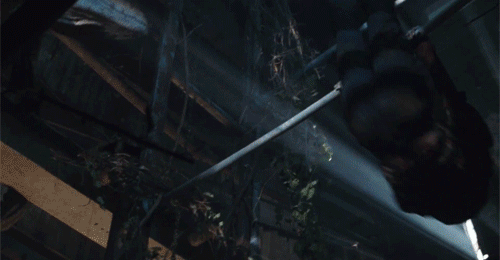 Press: How good at gymnastics are they?Colin Trevorrow: No comment. No comment. But, they do bad ass stuff. It's a real– Nick is 18 and Ty is 12. And so, it's older boys on an adventure in a really old school kind of way. We also can put them in a level of peril that you don't get to put children in that much anymore. It's very–children in perilous times.Press: Not like the old days.Colin Trevorrow: Yeah, not like the old days. We go there. And the kids say, shit. Hopefully it'll make the cut. But, these are the little details. When we say we love Amblin movies–.
Press: How good at gymnastics are they?Colin Trevorrow: No comment. No comment. But, they do bad ass stuff. It's a real– Nick is 18 and Ty is 12. And so, it's older boys on an adventure in a really old school kind of way. We also can put them in a level of peril that you don't get to put children in that much anymore. It's very–children in perilous times.Press: Not like the old days.Colin Trevorrow: Yeah, not like the old days. We go there. And the kids say, shit. Hopefully it'll make the cut. But, these are the little details. When we say we love Amblin movies–.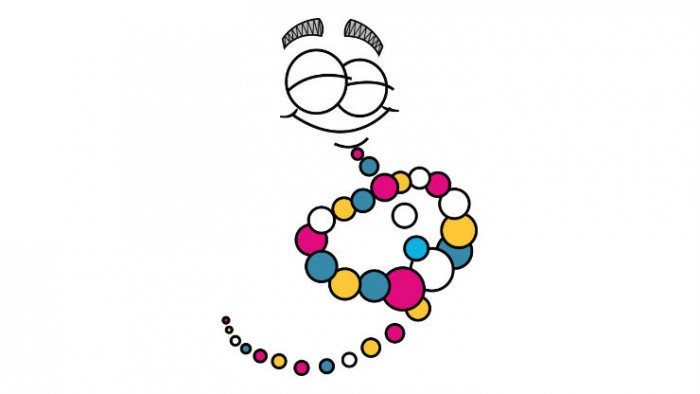
(Producer Frank Marshall joins the conversation)
Question: Is the cartoon DNA strand still welcoming visitors in the informational film?Colin Trevorrow: He does make an appearance.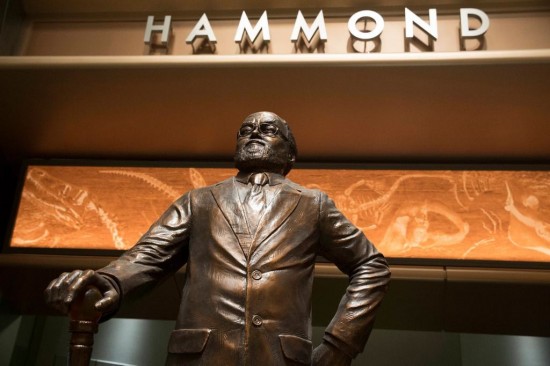 Question: I love the statue of John Hammond because it's almost like Walt Disney at Disneyland. Does he have more of a–is he seen at all elsewhere in the park?Colin Trevorrow: He's mentioned and referred to in many ways as, you know, there's something about that statute. When shot in certain ways, he looks very warm. And when in shot in terrifying situations, it looks like the clown in Pee Wee's Big Adventure where he's laughing at you. And he has this look that you're just, like, yeah, you probably could've warned us about this as well, your dream has gone horribly awry. You saw Irrfan here today. So, you know, Irrfan is the new face of where the money comes from. And he has a dream as well, but he also comes from a world in which, you know, large amounts of money will allow people to repeat mistakes that have been made in the past. But, you can feel him living in Hammond's shadow, and BD Wong's character is really who I thought was just the most organic link to the earlier films in looking at the reality. And now that you know what it's about, the idea that, like, Sam Neill would come to the park on this particular day. It's Die Hard 2. You know, it's, like, why is the same thing happening to the same guy three times? But, you know, Dr. Wu was underappreciated, and under recognized and now, he's reached a point where he's very wealthy and is very well recognized. And it just seemed like there was a way to build him into this that would feel completely real.
Question: I love the statue of John Hammond because it's almost like Walt Disney at Disneyland. Does he have more of a–is he seen at all elsewhere in the park?Colin Trevorrow: He's mentioned and referred to in many ways as, you know, there's something about that statute. When shot in certain ways, he looks very warm. And when in shot in terrifying situations, it looks like the clown in Pee Wee's Big Adventure where he's laughing at you. And he has this look that you're just, like, yeah, you probably could've warned us about this as well, your dream has gone horribly awry. You saw Irrfan here today. So, you know, Irrfan is the new face of where the money comes from. And he has a dream as well, but he also comes from a world in which, you know, large amounts of money will allow people to repeat mistakes that have been made in the past. But, you can feel him living in Hammond's shadow, and BD Wong's character is really who I thought was just the most organic link to the earlier films in looking at the reality. And now that you know what it's about, the idea that, like, Sam Neill would come to the park on this particular day. It's Die Hard 2. You know, it's, like, why is the same thing happening to the same guy three times? But, you know, Dr. Wu was underappreciated, and under recognized and now, he's reached a point where he's very wealthy and is very well recognized. And it just seemed like there was a way to build him into this that would feel completely real.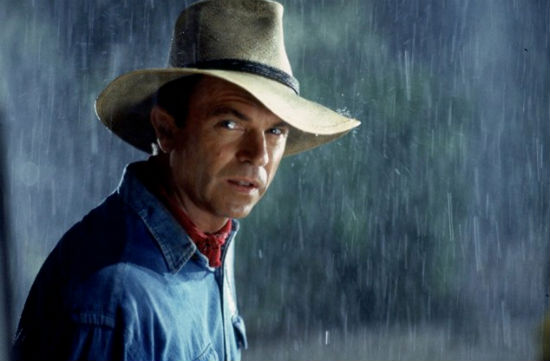 Question: So, what you're saying is that in Jurassic World II, when everything has gone to shit and they need somebody to come in and save it, and you have the park, that's when you can bring in Sam Neill.Colin Trevorrow: Yeah, you really got to need him. Yeah.Press: And Matt Damon.Colin Trevorrow: And Matt Damon. One of the expendables version where everybody fights dinosaurs.Press: Jurassic Expendables. Forget all the rest.Colin Trevorrow: Everybody.
Question: So, what you're saying is that in Jurassic World II, when everything has gone to shit and they need somebody to come in and save it, and you have the park, that's when you can bring in Sam Neill.Colin Trevorrow: Yeah, you really got to need him. Yeah.Press: And Matt Damon.Colin Trevorrow: And Matt Damon. One of the expendables version where everybody fights dinosaurs.Press: Jurassic Expendables. Forget all the rest.Colin Trevorrow: Everybody.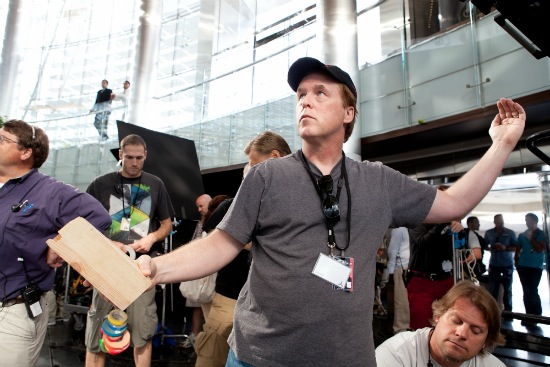 Question: So, Frank, can you tell us what you saw in Colin that you'd seen in Colin to give him this after all? He would tell us a little bit, but, you know, he doesn't have your perspective. After all the years you're trying to get [another Jurassic Park] made, what did Colin have to really bring it to the table?Frank Marshall: Well, it's basic storytelling. You know, he's–when we looked at his movie–actually, I have to go back because it's all Brad Bird's fault.Press: It connects to Star Wars?Frank Marshall: Yeah. So, it's all a family thing, which is when they [Disney and Lucasfilm] were looking for directors [for Star Wars 7], we were also looking for directors [for Jurassic World]. And Kathy [Kennedy] and I were talking one night and there was this kind of wild idea that Brad [Bird] had about how he could possibly do Star Wars and Tomorrowland at the same time. And he says "there is this guy that reminds me of me."Colin Trevorrow: Oh, Brad.Frank Marshall: And that he could depend on [Colin] to sort of prep everything and then he would step in and direct and of course, that's the kind of pie in the sky. I'm sure Kathy would have a little trouble going to Bob Iger with that.Frank Marshall: But, I said, well, okay, well, who is this guy? So, we screened the movie [Safety Not Guaranteed] and I kind of saw what Brad was thinking. And so, I don't know whether I called your manager to get your number or what happened.Colin Trevorrow: I remember–yeah, I think you called him and then you called me. I remember sitting at my house. "Frank Marshall's on the phone."Frank Marshall: And, we had this great conversation. I went to Steven [Spielberg] and I said, you know, I think there's somebody I'd like to bring out to meet. We had met a couple of people. I met a lot of people, but getting through me to the next step was–there weren't many. And [Colin] came out and we're here today, you know? It was just–it was the easiest thing I've done in a long time because it was so organic because we all wanted to make the same movie.Frank Marshall: He's a wonderful storyteller. And that's what the movie's about. It's about storytelling. It's not about action and dinosaurs. It's about "who are the characters?" And he had done such a wonderful job in the other movie that it really was sort of like we had a mini-Amblin going.Colin Trevorrow: Yeah. We were all talking about the things that we identify as being specifically Amblin and you probably wouldn't guess some of–like, one of them is, like, kids say shit sometimes. Like, there's–children are in peril.Frank Marshall: Yeah, yeah, yeah.Colin Trevorrow: Something you don't really get to do anymore. And it's just awesome that we get to–whether the kids say shit or not, we get to put children in peril in this movie and it's just seeing children in horrifying and terror situations is so deeply satisfying.
Question: So, Frank, can you tell us what you saw in Colin that you'd seen in Colin to give him this after all? He would tell us a little bit, but, you know, he doesn't have your perspective. After all the years you're trying to get [another Jurassic Park] made, what did Colin have to really bring it to the table?Frank Marshall: Well, it's basic storytelling. You know, he's–when we looked at his movie–actually, I have to go back because it's all Brad Bird's fault.Press: It connects to Star Wars?Frank Marshall: Yeah. So, it's all a family thing, which is when they [Disney and Lucasfilm] were looking for directors [for Star Wars 7], we were also looking for directors [for Jurassic World]. And Kathy [Kennedy] and I were talking one night and there was this kind of wild idea that Brad [Bird] had about how he could possibly do Star Wars and Tomorrowland at the same time. And he says "there is this guy that reminds me of me."Colin Trevorrow: Oh, Brad.Frank Marshall: And that he could depend on [Colin] to sort of prep everything and then he would step in and direct and of course, that's the kind of pie in the sky. I'm sure Kathy would have a little trouble going to Bob Iger with that.Frank Marshall: But, I said, well, okay, well, who is this guy? So, we screened the movie [Safety Not Guaranteed] and I kind of saw what Brad was thinking. And so, I don't know whether I called your manager to get your number or what happened.Colin Trevorrow: I remember–yeah, I think you called him and then you called me. I remember sitting at my house. "Frank Marshall's on the phone."Frank Marshall: And, we had this great conversation. I went to Steven [Spielberg] and I said, you know, I think there's somebody I'd like to bring out to meet. We had met a couple of people. I met a lot of people, but getting through me to the next step was–there weren't many. And [Colin] came out and we're here today, you know? It was just–it was the easiest thing I've done in a long time because it was so organic because we all wanted to make the same movie.Frank Marshall: He's a wonderful storyteller. And that's what the movie's about. It's about storytelling. It's not about action and dinosaurs. It's about "who are the characters?" And he had done such a wonderful job in the other movie that it really was sort of like we had a mini-Amblin going.Colin Trevorrow: Yeah. We were all talking about the things that we identify as being specifically Amblin and you probably wouldn't guess some of–like, one of them is, like, kids say shit sometimes. Like, there's–children are in peril.Frank Marshall: Yeah, yeah, yeah.Colin Trevorrow: Something you don't really get to do anymore. And it's just awesome that we get to–whether the kids say shit or not, we get to put children in peril in this movie and it's just seeing children in horrifying and terror situations is so deeply satisfying.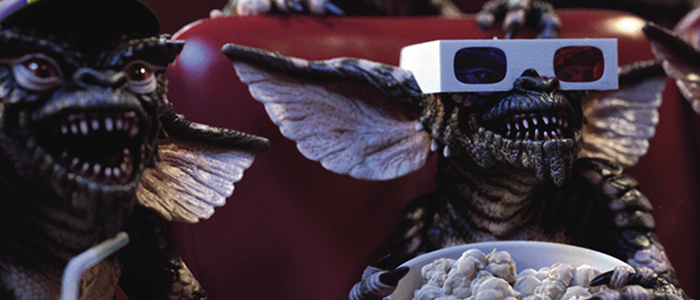 Frank Marshall: Well, people say to me, how did you make Gremlins? How did you ever get away with making Gremlins? And I go I don't know. We just did it. Gremlins has one of the best excuses for not involving the police when something goes down.Question: What was their reason?Frank Marshall: Well, it was actually–because they just don't believe them. And then there's the call back. ... And when he calls the sheriff, oh, yeah, just like, you know, those–.Press: Right. That was great.Frank Marshall: All the little green monsters that multiply when you put water on them.
Frank Marshall: Well, people say to me, how did you make Gremlins? How did you ever get away with making Gremlins? And I go I don't know. We just did it. Gremlins has one of the best excuses for not involving the police when something goes down.Question: What was their reason?Frank Marshall: Well, it was actually–because they just don't believe them. And then there's the call back. ... And when he calls the sheriff, oh, yeah, just like, you know, those–.Press: Right. That was great.Frank Marshall: All the little green monsters that multiply when you put water on them.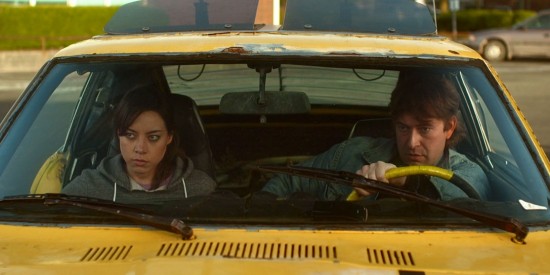 Question: Clever. I feel like Safety has that — has some real moments of wonder – especially in the ending. When I saw it at Sundance, the crowd got up on their feet and clapped. I'm sure that's what Steven must've seen in [Safety Not Guarenteed]. What I feel was missing from the last two Jurassic Park films is that wonder and that, like, kind of — I mean, it had the terror, but it didn't have...Colin Trevorrow: Right. Well, there was a disadvantage that they had and they couldn't — unless those characters thought they were going someplace that was going to be safe and wondrous, you don't — you have to manufacture that moment. And in both of those, it's like you're going to an island; you're probably going to die. And that's exactly what happens.
Question: Clever. I feel like Safety has that — has some real moments of wonder – especially in the ending. When I saw it at Sundance, the crowd got up on their feet and clapped. I'm sure that's what Steven must've seen in [Safety Not Guarenteed]. What I feel was missing from the last two Jurassic Park films is that wonder and that, like, kind of — I mean, it had the terror, but it didn't have...Colin Trevorrow: Right. Well, there was a disadvantage that they had and they couldn't — unless those characters thought they were going someplace that was going to be safe and wondrous, you don't — you have to manufacture that moment. And in both of those, it's like you're going to an island; you're probably going to die. And that's exactly what happens.
No, that's my favorite thing about this.
Frank Marshall: Well, and that was the pitch that really got us because the story we were on the track of was not this story. And it was Colin's pitch of we need to go back to what we did in the first movie. And enter the park in wonderment and joy and happiness and deliver what they're originally dreaming and then it can go up and everybody dies. It makes it all the more horrible when things do.Colin Trevorrow: Yeah. Well, that was another thing that was important to us is that we didn't. I feel like my whole career will be a struggle against being derivative just because I grew up on a very specific set of movies. And my instincts all come from there. So it's constantly an effort to invent, invent, invent. And to not have a movie that felt like a retread, even from a narrative standpoint. We didn't want the park to break down from an infrastructure standpoint. We had to find another way. And every single thing, finding another way to make this little detail happen so on a whole, it lives as its own piece. And to me, it feels — I think when you see this movie, it makes Jurassic Park – I don't want say it feels like a prequel because it's an incredible movie and this movie can't be better than that movie. It's just literally impossible because you can't ever see that for the first time again. But, it feels like that movie is telling you the history of how this massive thing was made possible. It's very cool to watch it. And when we get to see this movie, you'll be able to watch Jurassic Park in the context of this movie. I think it's a great companion piece to that movie.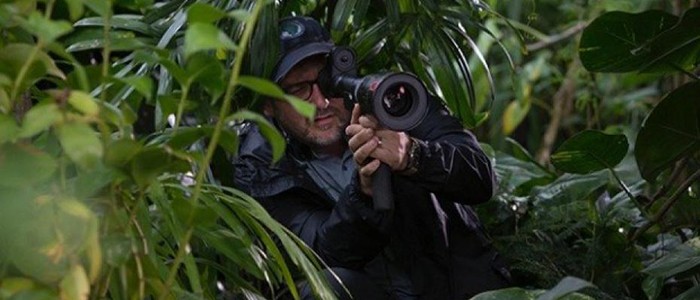 Question: Looking ahead to your editing phase, I mean, you're going to be–wrap this soon, but you have a whole other year, essentially. What does that feel like? Are you looking forward to that process?Colin Trevorrow: We've been cutting all along as we've been shooting. And so, I've seen a lot of the movie and I'm very confident that it's working and it feels spontaneous and real and fun and all the things I want it to be. So, I'm just looking forward to it. I think it's going to be a blast. And we get–you know, we're moving to L.A. for a year and, I get to edit Jurassic World. Come on. It's going to be great.Question: You're living with it longer than you would with Safety Not Guaranteed where the turnaround is much faster. Here, you're looking to–.Colin Trevorrow: –Yeah, we were saying, I've now shot four Safety Not Guaranteed since I've been here, entering the fifth this week. No, regardless of the size of the movie, sometimes a little movie like Safety can take longer to cut than a big movie just because of the resources and it was, like, me and a guy in his studio apartment. But, I think the active honing–there'll be the version that will be the movie, but then that last 10 percent is always the hardest. And the last 10 percent is actually the last 90 percent in a lot of ways. It's just like really getting it to work on all of the levels. So, that part, I look forward to the most.
Question: Looking ahead to your editing phase, I mean, you're going to be–wrap this soon, but you have a whole other year, essentially. What does that feel like? Are you looking forward to that process?Colin Trevorrow: We've been cutting all along as we've been shooting. And so, I've seen a lot of the movie and I'm very confident that it's working and it feels spontaneous and real and fun and all the things I want it to be. So, I'm just looking forward to it. I think it's going to be a blast. And we get–you know, we're moving to L.A. for a year and, I get to edit Jurassic World. Come on. It's going to be great.Question: You're living with it longer than you would with Safety Not Guaranteed where the turnaround is much faster. Here, you're looking to–.Colin Trevorrow: –Yeah, we were saying, I've now shot four Safety Not Guaranteed since I've been here, entering the fifth this week. No, regardless of the size of the movie, sometimes a little movie like Safety can take longer to cut than a big movie just because of the resources and it was, like, me and a guy in his studio apartment. But, I think the active honing–there'll be the version that will be the movie, but then that last 10 percent is always the hardest. And the last 10 percent is actually the last 90 percent in a lot of ways. It's just like really getting it to work on all of the levels. So, that part, I look forward to the most.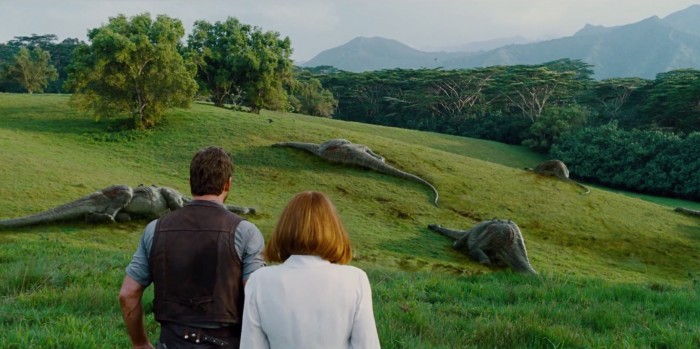 Question: Are you shooting performance capture on set? Or is that going to be, like, after principal photography?Colin Trevorrow: That'll be after. What we did–we had actually stand-ins, these guys that were the best who all came in and they had these raptor heads on. And at first, I think they all thought they were motion capture. And so, I would tell everyone, like, don't tell them they're not because it's amazing what they're doing. And they would get in and they would be the raptors and it was done. And they would, like, dance together and it was the best. We do one take just using them as a guide. And it's great just for size if you have someone facing off with something that they could actually interact with. But, it's amazing. You can do it essentially in real time now. So, you can have the image up and you have someone moving around a space and you can watch them placed right into your image and it's extraordinary technology.
Question: Are you shooting performance capture on set? Or is that going to be, like, after principal photography?Colin Trevorrow: That'll be after. What we did–we had actually stand-ins, these guys that were the best who all came in and they had these raptor heads on. And at first, I think they all thought they were motion capture. And so, I would tell everyone, like, don't tell them they're not because it's amazing what they're doing. And they would get in and they would be the raptors and it was done. And they would, like, dance together and it was the best. We do one take just using them as a guide. And it's great just for size if you have someone facing off with something that they could actually interact with. But, it's amazing. You can do it essentially in real time now. So, you can have the image up and you have someone moving around a space and you can watch them placed right into your image and it's extraordinary technology.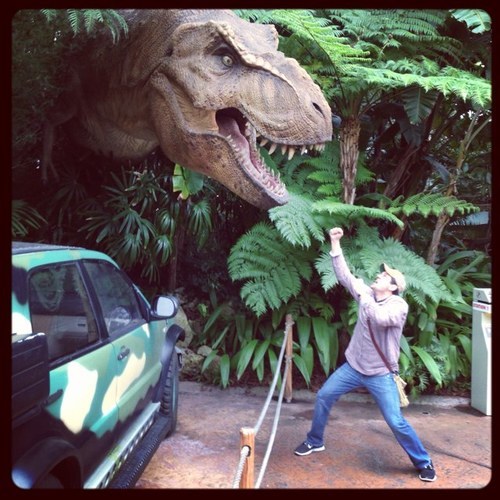 Question: Do you guys have a composer yet? Colin Trevorrow: We do, yeah. Michael Giacchino.Press: Oh, perfect. Perfect. Is the Williams score still going to be in there or–?Colin Trevorrow: –We are going to–yes. Yes, it will. You know, Michael has been pretty great at — he brought a little bit of the original Star Trek TV show score in and he manages to do it and build something totally bold and new while still letting you have that sense it's–the moments when that score is used, I can't use it when you see a dinosaur, though. It's got to be used for something else. And to me, the moment of wonder is when you see that the park exists. The park is real. And then we'll go to new places, hopefully.Press: Oh, that's where the–in the original where the score kicks in the most.Colin Trevorrow: Yeah.Press: You know, one of my favorite moments in the whole movie, it has nothing to do with the dinosaur. It's when John Hammond goes, there she–there it is.Colin Trevorrow: Yeah. Yeah.Press: You know, then the score sweeps up and you're landing on the platform.Colin Trevorrow: Yeah. Yeah, yeah. Yeah.
Question: Do you guys have a composer yet? Colin Trevorrow: We do, yeah. Michael Giacchino.Press: Oh, perfect. Perfect. Is the Williams score still going to be in there or–?Colin Trevorrow: –We are going to–yes. Yes, it will. You know, Michael has been pretty great at — he brought a little bit of the original Star Trek TV show score in and he manages to do it and build something totally bold and new while still letting you have that sense it's–the moments when that score is used, I can't use it when you see a dinosaur, though. It's got to be used for something else. And to me, the moment of wonder is when you see that the park exists. The park is real. And then we'll go to new places, hopefully.Press: Oh, that's where the–in the original where the score kicks in the most.Colin Trevorrow: Yeah.Press: You know, one of my favorite moments in the whole movie, it has nothing to do with the dinosaur. It's when John Hammond goes, there she–there it is.Colin Trevorrow: Yeah. Yeah.Press: You know, then the score sweeps up and you're landing on the platform.Colin Trevorrow: Yeah. Yeah, yeah. Yeah.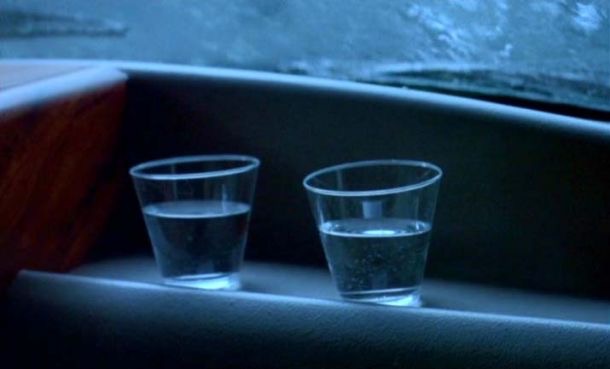 Question:When you were writing the script, was there any attempt–I know that you don't want to redo Jurassic Park. But, was there any attempt to, like, oh, there's that great scene with the cup and the water or whatever, we need something like that? Or–.
Question:When you were writing the script, was there any attempt–I know that you don't want to redo Jurassic Park. But, was there any attempt to, like, oh, there's that great scene with the cup and the water or whatever, we need something like that? Or–.
Colin Trevorrow: –That's always a goal, to create iconic images at every step of the way, but that's been something more here as where in any environment as opposed to planning something. Just if we see something–I mean, I wasn't there for that. I imagine that that came in the process of being there and what if this happened. And that's where–we have this one shot that–there's several, but there's one shot that I love where we had Bryce running away from something, a dinosaur, say, and we had–we saw her feet. Like, her feet were touching down in these puddles.
And so, we did this close up shot of just her high heels, like, running and splashing into these puddles with these giant feet behind it, like out of focus. And we just were, like, okay, oh, that's going to be cool. That's a thing.
